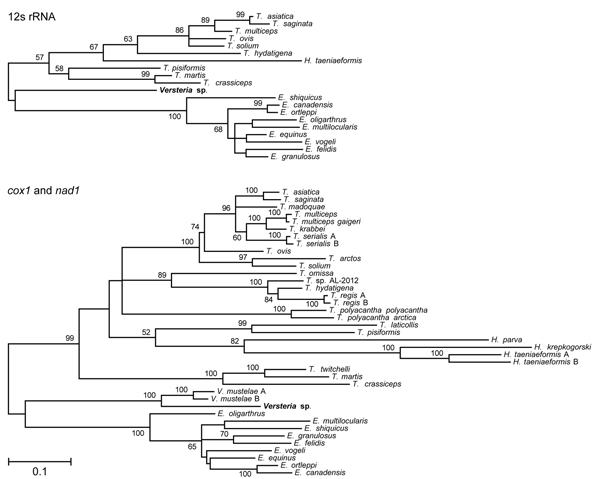Volume 20, Number 1—January 2014
Dispatch
Fatal Metacestode Infection in Bornean Orangutan Caused by Unknown Versteria Species
Figure 2

Figure 2. . Phylogenetic trees of the Taeniidae, including newly generated sequences derived from tissues of a fatally infected Bornean orangutan. Trees were constructed from DNA sequence alignments of 12s rRNA (A) and concatenated cox1/nad1 (B) sequences from the orangutan (Versteria sp.; bold; accession nos. KF303339–303341) and representative Echinococcus, Hydatigera, Taenia, and Versteria sequences from GenBank (see Table). The maximum likelihood method was used, with the likeliest model of molecular evolution chosen for both datasets by using MEGA5.2 software (6). Models of molecular evolution and tree likelihood values are HKY+G, -lnL = 2279.42 for 12s rRNA, and GTR+G+I, -lnL = 11582.71 for cox1/nad1. Numbers next to branches indicate bootstrap values (%), estimated from 1,000 resamplings of the data (only bootstrap values ≥50% are shown). Scale bar indicates nucleotide substitutions per site.
References
- Nakao M, Lavikainen A, Iwaki T, Haukisalmi V, Konyaev S, Oku Y, Molecular phylogeny of the genus Taenia (Cestoda: Taeniidae): proposals for the resurrection of Hydatigera Lamarck, 1816 and the creation of a new genus Versteria. Int J Parasitol. 2013;43:427–37. DOIPubMedGoogle Scholar
- Lauck M, Hyeroba D, Tumukunde A, Weny G, Lank SM, Chapman CA, Novel, divergent simian hemorrhagic fever viruses in a wild Ugandan red colobus monkey discovered using direct pyrosequencing. PLoS ONE. 2011;6:e19056. DOIPubMedGoogle Scholar
- Locke DP, Hillier LW, Warren WC, Worley KC, Nazareth LV, Muzny DM, Comparative and demographic analysis of orang-utan genomes. Nature. 2011;469:529–33. DOIPubMedGoogle Scholar
- Tsai IJ, Zarowiecki M, Holroyd N, Garciarrubio A, Sanchez-Flores A, Brooks KL, The genomes of four tapeworm species reveal adaptations to parasitism. Nature. 2013;496:57–63 . DOIPubMedGoogle Scholar
- Bowles J, Blair D, McManus DP. A molecular phylogeny of the genus Echinococcus. Parasitology. 1995;110:317–28. DOIPubMedGoogle Scholar
- Tamura K, Peterson D, Peterson N, Stecher G, Nei M, Kumar S. MEGA5: molecular evolutionary genetics analysis using maximum likelihood, evolutionary distance, and maximum parsimony methods. Mol Biol Evol. 2011;28:2731–9. DOIPubMedGoogle Scholar
- Lavikainen A, Haukisalmi V, Lehtinen MJ, Henttonen H, Oksanen A, Meri S. A phylogeny of members of the family Taeniidae based on the mitochondrial cox1 and nad1 gene data. Parasitology. 2008;135:1457–67. DOIPubMedGoogle Scholar
- Langham RF, Rausch RL, Williams JF. Cysticerci of Taenia mustelae in the fox squirrel. J Wildl Dis. 1990;26:295–6. DOIPubMedGoogle Scholar
- Kinsella JM. Comparison of helminth parasites of the cotton rat, Sigmodon hispidus, from several habitats in Florida. Am Mus Novit. 1974;2540:1–12.
- Baer JG, Fain A. Cestodes nouveaux du Congo Belge. Acta Trop. 1951;8:59–63.
- Loos-Frank B. An up-date of Verster's (1969) 'Taxonomic revision of the genus Taenia Linnaeus' (Cestoda) in table format. Syst Parasitol. 2000;45:155–84. DOIPubMedGoogle Scholar
- Lipkin WI, Firth C. Viral surveillance and discovery. Curr Opin Virol. 2013;3:199–204.
- Whitfield PJ, Evans NA. Parthenogenesis and asexual multiplication among parasitic platyhelminths. Parasitology. 1983;86:121–60. DOIPubMedGoogle Scholar
- Mackinnon J. The behaviour and ecology of wild orang-utans (Pongo pygmaeus). Anim Behav. 1974;22:3–74. DOIGoogle Scholar